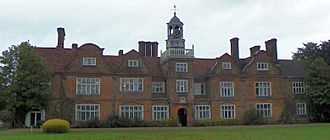Rothamsted Manor facts for kids
Quick facts for kids Rothamsted Manor |
|
|---|---|

The manor house
|
|
| General information | |
| Town or city | Harpenden Rural |
| Country | England |
| Construction started | 17th century |
Rothamsted Manor is a really old and cool building in Harpenden Rural, a village in Hertfordshire, England. It used to be a big country home, and now it's a place where people hold events like weddings. Part of the building is from the 1600s! The land around it is home to the famous Rothamsted Research Centre, which studies farming. This manor is so important that it's a "Grade I listed building," meaning it's protected because of its special history and architecture.
Contents
Discovering Rothamsted Manor's Past
Rothamsted Manor has a long and interesting history, going back hundreds of years.
Early Days of the Manor
The very first time we hear about Rothamsted is in a record from 1212. Back then, a person named Richard de Merston owned the land. Just a few years later, in 1221, documents mention a house with its own small chapel and a garden.
Over the centuries, the manor changed hands many times.
- By 1292, the Nowell family owned it.
- Then, by 1355, it belonged to the Cresseys.
- And by 1525, the Bardolph family took over.
By this time, Rothamsted was a pretty big house, with at least 16 rooms!
The Wittewronge Family's Influence
In 1623, the Bardolph family sold Rothamsted to Anne Wittewronge. Her family, the Wittewronges, were Calvinists. They had left their home in Ghent in 1564 to escape religious problems. They even started a brewery in London!
Anne's son, Sir John Wittewronge, was very important to the manor's look. In the 1600s, he gave the house its special Dutch style. The Wittewronge family lived at Rothamsted until 1763. After Thomas Wittewronge passed away, the manor went to his cousin, John Bennet. Later, John Bennet left the manor to his nephew, John Bennet Lawes.
Rothamsted and Farming Science
A very important person named Sir John Bennet Lawes came next. He was the son of the earlier John Bennet Lawes. In 1843, Sir John Bennet Lawes started something amazing on the manor grounds: the Rothamsted Experimental Station. This was a special place for researching farming. It was one of the first of its kind in the world!
In 1931, Sir John's family decided to sell the estate. But people really wanted the Experimental Station to keep its home. So, after a big public effort to raise money, the Experimental Station was able to buy the estate in 1934.
Rothamsted Today
A few years later, in 1938, the local council bought a part of the estate. This area is now called Rothamsted Park. They wanted to make sure there were playing fields for everyone and to keep the land as an open, green space.
The rest of the estate is still used by Rothamsted Research, which is what the Experimental Station is called now. The manor house itself used to be a place for staff to live. But today, it's mostly used for different events, like parties and meetings.
Rothamsted's Global Inspiration
Did you know that Rothamsted Manor even inspired a building far away? A New Zealand architect named Frederick Strouts used Rothamsted Manor as his idea for designing Ivey Hall. This building was built between 1878 and 1880 and is now the main building of Lincoln University in New Zealand!
Images for kids



